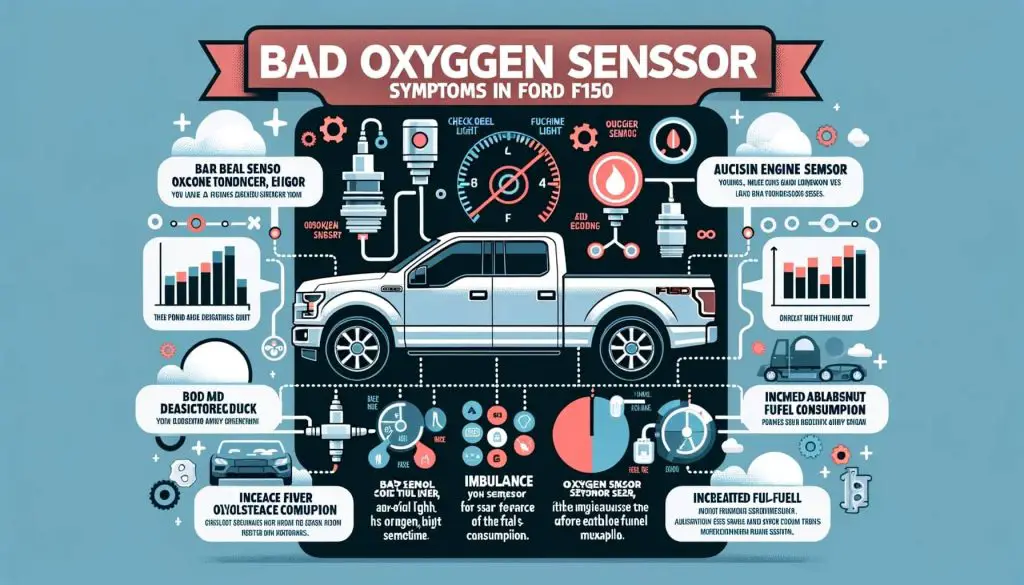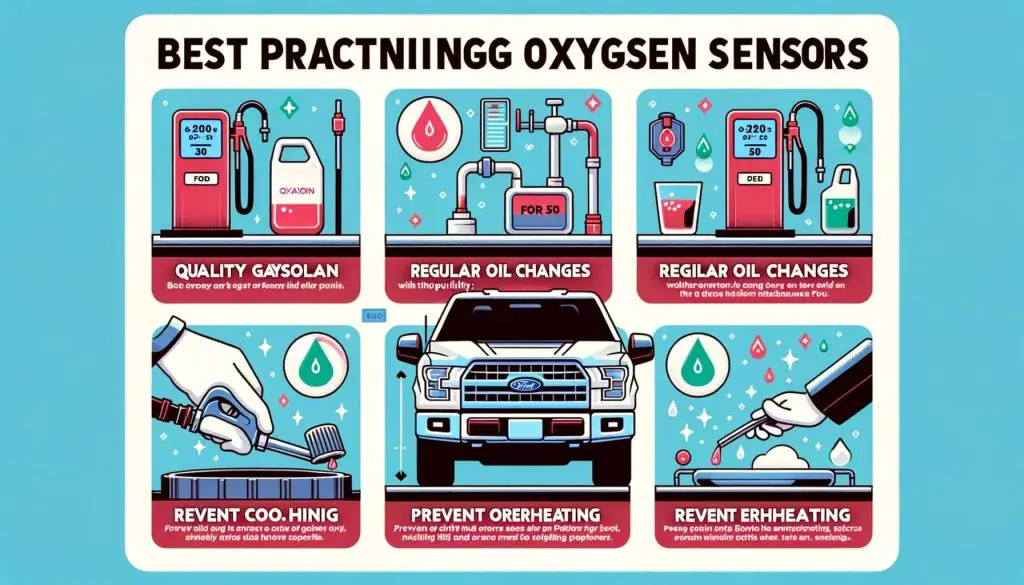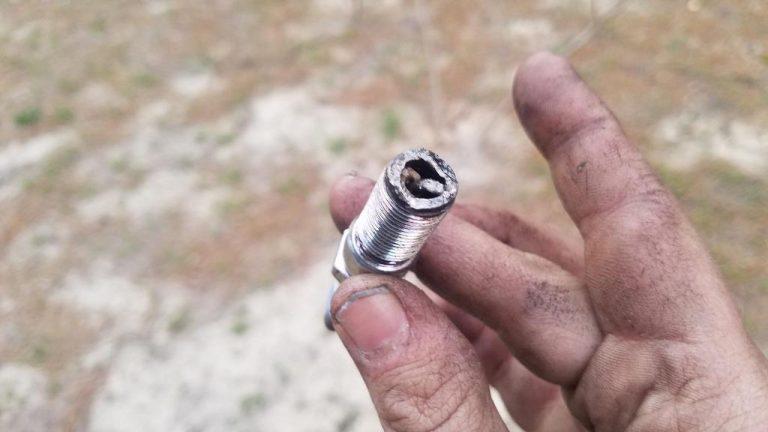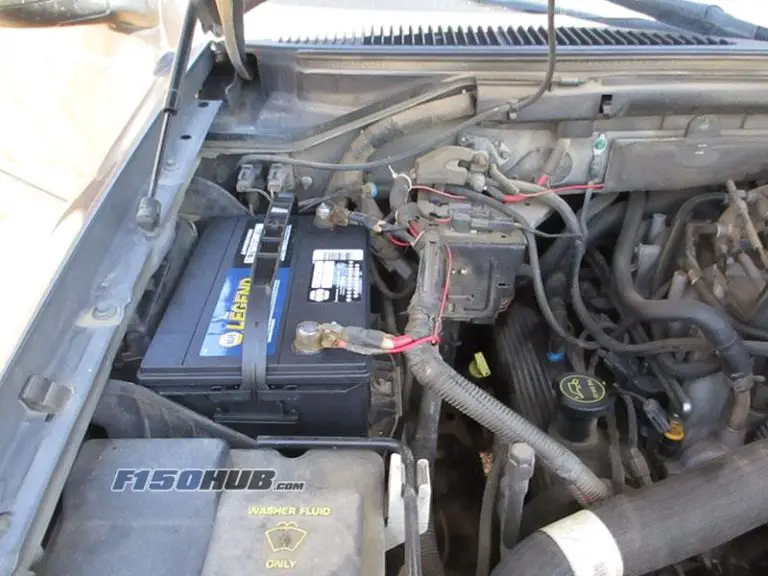How Many O2 Sensors Does a Ford F150 Have
A Ford F150 has four oxygen (O2) sensors. Two are located upstream of the catalytic converters and two are located downstream.
The upstream sensors monitor the amount of oxygen in the exhaust before it enters the catalytic converters, and the downstream sensors monitor the amount of oxygen in the exhaust after it exits the catalytic converters.
The upstream sensors are used to adjust the air-fuel mixture, while the downstream sensors are used to monitor the efficiency of the catalytic converters. If any of the O2 sensors fail, it can cause the engine to run poorly and increase emissions.
In this guide, we’ll delve into:
- Symptoms of a malfunctioning oxygen sensor and how to identify them.
- A step-by-step guide to replacing these sensors.
- Cost implications of sensor replacement.
- Essential maintenance tips to prolong the life of your O2 sensors.
Dive in to ensure your Ford F150 stays in peak condition!
Bad Oxygen Sensor Symptoms in Ford F150
A malfunctioning oxygen sensor in your Ford F150 can lead to a myriad of issues, some subtle and others more evident.
Early identification and resolution can not only save on fuel costs but also prevent more significant engine problems down the line.

Identifying Potential Issues
Understanding the signs of a failing O2 sensor is crucial for the longevity and performance of your Ford F150.
- Check Engine Light Activation: One of the most common and recognizable symptoms of a problematic oxygen sensor is the activation of the check engine light. It’s the vehicle’s way of signaling that something is amiss within the engine or its components.
- Variations in Fuel Economy: A malfunctioning O2 sensor can lead to an imbalanced air-fuel mixture, causing the engine to consume more fuel than necessary. If you notice that you’re refueling more frequently without additional mileage, it might be time to inspect the oxygen sensors.
Additional Diagnostic Tips
For those who like to be hands-on or want a more in-depth understanding of the potential problem, here are some steps to further diagnose O2 sensor issues:
- Utilizing a Scan Tool: Modern vehicles come equipped with an array of sensors and computers. By using a scan tool, you can read the error codes stored in the vehicle’s computer. These codes can provide insights into which sensor might be malfunctioning and its nature of dysfunction.
How To Replace Ford F150 Oxygen Sensors
Proper maintenance of your Ford F150 also involves ensuring the oxygen sensors, vital for optimal engine performance and emissions control, are in peak condition.
Replacing these sensors might seem a daunting task, yet, with the right guide, you can perform this maintenance routine right at home. Here’s a detailed guide to assist you in this process.

Tools and Materials Needed
To ensure a smooth replacement process, gather the following tools and materials:
| Tool/Material | Use | Additional Notes |
|---|---|---|
| New oxygen sensors | Replace faulty sensors | Ensure compatibility with your Ford F150 model |
| Oxygen sensor socket | To unscrew and install the sensors | Specific size may be required |
| Ratchet set | Assists in removing and securing the sensor | |
| Penetrating oil | Loosens stuck or rusted sensors | Allow to sit for a few minutes before attempting removal |
| Gloves | Protects hands from grime and potential sharp edges | Sturdy work gloves are recommended |
| Safety glasses | Protects eyes from debris | Ensure they provide a clear view and fit well |
Ensure you’re choosing the correct type of oxygen sensor, either heated or non-heated, according to your vehicle’s specifications.
Step-by-Step Guide to Sensor Replacement
A methodical approach ensures a hassle-free replacement of the oxygen sensors. Here’s a succinct guide:
- Locate the Sensors: Identify the upstream and downstream sensors.
- Apply Penetrating Oil: Aid in loosening the sensors for removal.
- Remove the Old Sensors: Use the oxygen sensor socket and ratchet.
- Install the New Sensors: Applying anti-seize lubricant and securing them with appropriate torque.
- Connect to the Wiring Harness: Ensure secure and accurate connections.
Additional Tips and Safety Precautions
Replacing oxygen sensors is relatively straightforward, yet requires a meticulous approach. Always ensure:
- Safety First: Wear protective gear like gloves and glasses.
- Cool Engine: Only work on a cool engine to avoid burns.
- Correct Tools: Utilize the correct tools to prevent damage to components.
- Sensor Handling: Handle the new sensors with care, avoiding contact with the sensor tip.
Post-Replacement Steps
After successfully installing the new sensors:
- Reset the Check Engine Light: You can utilize a scan tool or simply disconnect the battery for approximately 30 seconds.
- Conduct a Test Drive: Ensure the vehicle is operating smoothly without any warning lights activating.
In case you ever encounter challenges or uncertainties during the replacement, seeking professional help is always a wise decision to avoid unintentional damage or incorrect installation.
Costs Associated with Ford F150 Oxygen Sensor Replacement
Navigating through the financial aspects of replacing the oxygen sensors on your Ford F150 doesn’t have to be a puzzle.
With a well-structured budget and some savvy tips, you can manage the replacement costs effectively.
Let’s delve into the financial components and tips for managing costs associated with oxygen sensor replacement.

Pricing Breakdown
Understanding the costs involves dissecting them into two primary components: the cost of the sensors themselves and labor charges.
- Cost per Sensor: On average, oxygen sensors for the Ford F150 can range between \$50 and \$150 each, depending on the brand, type (heated or non-heated), and where they are purchased from.
- Labor Charges: Depending on your location and the mechanic’s rate, labor costs can range from \$50 to \$100 per sensor for installation.
Example Cost Calculation Table
| Item | Quantity | Cost per Item | Total Cost |
|---|---|---|---|
| Oxygen Sensor (Upstream) | 2 | \$100 | \$200 |
| Oxygen Sensor (Downstream) | 2 | \$120 | \$240 |
| Labor Cost | 4 | \$75 | \$300 |
| Total | \$740 |
Money-Saving Tips
While replacing oxygen sensors is crucial for maintaining your Ford F150, there are ways to mitigate the financial impact.
- DIY Replacements: If you’re mechanically inclined, consider installing the sensors yourself, which eliminates labor costs. Utilize guides and manuals to assist you through the process.
- Purchase Sensors Independently: Buying sensors from online retailers or auto parts stores often proves to be cost-effective as opposed to purchasing directly through a mechanic or dealership.
- Specialized Mechanics: Opting for mechanics who specialize in Ford vehicles might avail you of discounts or package deals for sensor replacement.
Balancing your budget while ensuring your Ford F150’s oxygen sensors are in top shape is a practical approach to vehicle maintenance.
Regardless of whether you opt for a DIY replacement or choose a professional mechanic, ensuring the health of your oxygen sensors is paramount in maintaining optimal vehicle performance and efficiency. Your vehicle, after all, deserves the care invested into it!
Where is the Camshaft Position Sensor Located on a Ford F150 5.0?
The ford f 150 camshaft position sensor is typically located near the cylinder head, on or around the engine block itself. On the 5.0-liter engine, it can generally be found on the front of the engine, between the engine and the radiator. Its specific position can vary slightly depending on the exact model year of the vehicle.
Can the Ford Wifi still be used when the vehicle is turned off?
Yes, the Ford WiFi can still be used when the vehicle is turned off. With the advanced technology installed, Ford vehicles are designed to provide WiFi connectivity even when the engine is not running. This ensures continuous access to the internet, allowing users to stay connected and enjoy online activities ford wifi when vehicle is off.
Maintenance Tips for Ford F150 Oxygen Sensors
Proactive care is key when it comes to vehicle maintenance. Ensuring the longevity and optimal functioning of the oxygen sensors in your Ford F150 is no exception.
With a combination of regular inspections, mindful driving, and adherence to preventive measures, you can extend the lifespan of these crucial components, maintaining the efficient running of your vehicle.

Ensuring Longevity and Optimal Function
Your Ford F150’s oxygen sensors play a pivotal role in balancing your vehicle’s performance and emission control. Here’s how to safeguard them for the long haul.
- Quality Gasoline: Always opt for high-quality gasoline, free from contaminants that could potentially damage oxygen sensors.
- Regular Oil Changes: Consistently clean oil is pivotal in preventing the clogging of oxygen sensors and ensuring they function efficiently.
- Prevent Overheating: Keeping your engine cool and avoiding overheating circumstances can prolong the life of your oxygen sensors.
Regular Inspection and Preventative Measures
Routine checks and preemptive actions can save you from unexpected sensor malfunctions and associated costs.
- Visual Checks: Periodic visual inspections for any signs of wear, rust, or damage to the oxygen sensors can preclude potential issues.
- Avoid Fuel Additives: Some fuel additives contain chemicals that might jeopardize the health of your oxygen sensors, using them sparingly or not at all is advisable.
Driving Habits to Enhance Sensor Lifespan
Cognizant driving habits can inadvertently contribute to the longevity of your oxygen sensors.
- Smooth Acceleration: Considerate acceleration and deceleration avoid putting undue stress on the engine and, by extension, the oxygen sensors.
- Avoid Harsh Conditions: Limiting drives through harsh conditions like deep water or excessively dusty environments protects the sensors from premature wear.
In essence, a diligent approach towards the maintenance of the oxygen sensors in your Ford F150 not only ensures that they endure but also aids in maintaining a healthy, efficiently running vehicle.
By adhering to these guidelines, you foster a stable operational environment for the sensors, thereby safeguarding your vehicle’s overall performance and emission control functionalities. Your conscious efforts today pave the way for a smoother drive tomorrow!
Where is the Map Sensor Located on a 2006 Ford F150 4.6?
The ford f150 map sensor location can be found on the intake manifold of a 2006 model equipped with a 4.6-liter engine. This sensor plays a crucial role in the engine’s performance by monitoring the intake manifold pressure and providing data to the engine control unit. Identifying its location allows for easy maintenance and troubleshooting.
Conclusion
In wrapping up, understanding “How Many O2 Sensors Does a Ford F150 Have” is pivotal for every Ford F150 owner. These sensors play an indispensable role in your vehicle’s performance and emissions control.
Regular maintenance and timely replacements ensure not only the longevity of these sensors but also the optimal functioning of your F150. Stay informed and drive smartly!







